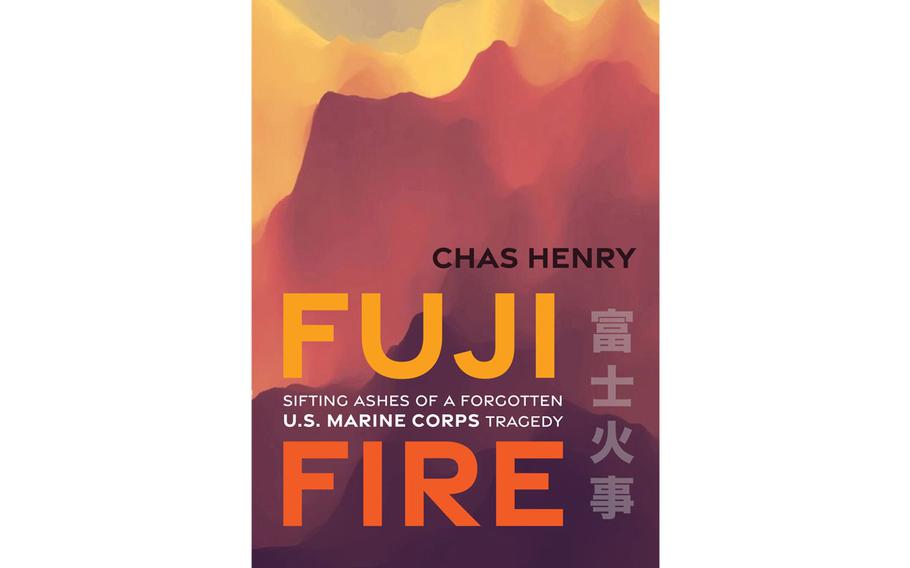
A burn victim is carried out of an ambulance and toward a C-141 Air Force plane on Oct. 22, 1979. The plane was one of two C-141s sent to Japan by the 9th Air Evacuation Hospital at Clark Air Base, Philippines, to fly 38 Marines burned in the Camp Fuji fire to Brooke Army Medical Center in San Antonio, Texas. (Stars and Stripes)
A retired Marine’s new book recounts the 1979 fire that killed 13 Marines and injured more than 70 others at a U.S. military training center near the base of Mount Fuji.
“Fuji Fire: Sifting Ashes of a Forgotten U.S. Marine Corps Tragedy” is the result of four years of research and more than 100 interviews conducted by retired Marine Capt. Chas Henry, a former broadcast journalist.
The blaze broke out on Oct. 19, 1979, at what is now known as Combined Arms Training Center Camp Fuji, during Typhoon Tip, the most powerful tropical cyclone on record. The storm struck much of Japan, including the area surrounding the 12,389-foot mountain southwest of Tokyo.
Camp Fuji holds an annual memorial ceremony at a stone monument honoring the Marines and sailors who died or were injured in the blaze.
Henry said the inspiration for the book came after he realized the fire had largely faded from memory. In 2019, he posted about the incident on social media along with a photo of himself at Camp Fuji in 1978.
“I was taken aback that the fire was so little remembered,” Henry said in a phone interview Wednesday from Washington, D.C.

“Fuji Fire: Sifting Ashes of a Forgotten U.S. Marine Corps Tragedy” is the result of four years of research and more than 100 interviews conducted by retired Marine Capt. Chas Henry, a former broadcast journalist. (Potomac Books)
While stuck at home during the COVID-19 pandemic, Henry began researching the blaze, which occurred shortly after his visit to Camp Fuji as part of the Hawaii-based 31st Marine Amphibious Unit.
“It was winter,” he said. “The accommodations were sparse, but I remember the kerosene heaters kept them warm.”
At the time, Camp Fuji stored about 5,000 gallons of fuel in rubber bladders situated on higher ground behind Quonset huts. Tip’s 190-mph winds ruptured one of the bladders, sending fuel down the hillside. A kerosene heater reportedly ignited the stream of gasoline.
Dozens of Marines with severe burns were evacuated to hospitals in Gotemba and Yokota Air Base in western Tokyo. Many were later flown to an Army burn center in San Antonio, Texas.
Henry, a Gulf War veteran, said he tracked down individuals named in the official report on the fire and interviewed about 130 people for the book, which was published June 1 by Potomac Books.
He spoke with Marines who were burned or escaped the blaze, as well as medical and air crews from Yokota, Camp Zama and Naval Air Facility Atsugi. He also interviewed caregivers from the Texas burn center.
Timothy Terrell, a Navy corpsman at Camp Fuji during the fire, said he was impressed by the depth of Henry’s research.
“There were things I did not know about,” he said in a July 4 email to Stars and Stripes. “Questions that I asked myself for years have been answered.”
Former Marine Steve Neal, severely burned in the fire, also found the book revealing.
“I consider myself among the very fortunate and humbled by the many heartbreaking personal stories that I was unaware of,” he said by email July 4.
Henry returned to Camp Fuji in April 2023 while researching the book to find the facility had changed drastically from the spartan camp of the 1970s.
The Marine Corps improved safety at Camp Fuji after the fire, but modern-day Marines don’t learn much about it, he said.
“There are lessons to be learned with regard to safety, accountability and leadership,” he said.
Some front pages from Stars and Stripes coverage of the fire